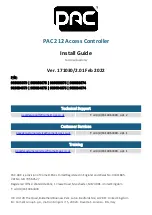
DocID024995 Rev 4
71/104
STM32L100RC
96
To complete these trials, ESD stress can be applied directly on the device, over the range of
specification values. When unexpected behavior is detected, the software can be hardened
to prevent unrecoverable errors occurring (see application note AN1015).
Electromagnetic Interference (EMI)
The electromagnetic field emitted by the device are monitored while a simple application is
executed (toggling 2 LEDs through the I/O ports). This emission test is compliant with
IEC 61967-2 standard which specifies the test board and the pin loading.
6.3.11 Electrical
sensitivity characteristics
Based on three different tests (ESD, LU) using specific measurement methods, the device is
stressed in order to determine its performance in terms of electrical sensitivity.
Electrostatic discharge (ESD)
Electrostatic discharges (a positive then a negative pulse separated by 1 second) are
applied to the pins of each sample according to each pin combination. The sample size
depends on the number of supply pins in the device (3 parts × (n+1) supply pins). This test
conforms to the JESD22-A114/C101 standard.
Table 37. EMI characteristics
Symbol Parameter
Conditions
Monitored
frequency band
Max vs. frequency range
Unit
4 MHz
voltage
range 3
16 MHz
voltage
range 2
32 MHz
voltage
range 1
S
EMI
Peak level
V
DD
=
V,
T
A
=
25 °C,
package
compliant with IEC
61967-2
0.1 to 30 MHz
3
-6
-5
dBµV
30 to 130 MHz
18
4
-7
130 MHz to 1GHz
15
5
-7
SAE EMI Level
2.5
2
1
-
Table 38. ESD absolute maximum ratings
Symbol
Ratings
Conditions
Class
Maximum
value
(1)
1.
Guaranteed by characterization results, not tested in production.
Unit
V
ESD(HBM)
Electrostatic discharge
voltage (human body
model)
T
A
=
+25 °C, conforming to
JESD22-A114
2
2000
V
V
ESD(CDM)
Electrostatic discharge
voltage (charge device
model)
T
A
=
+25 °C, conforming to
ANSI/ESD STM5.3.1.
II
500
V
微可Vicor——值得信赖的元器件供应商
http://www.vicor.top/
021-31660491
微可Vicor——值得信赖的元器件供应商
http://www.vicor.top/
021-31660491
















































